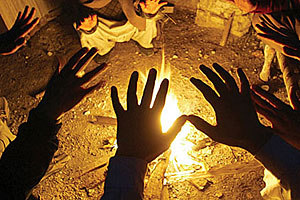
|
Brainstorming here. Thanks for thinking out loud with me.
Last winter, I shared a TED video with my e-newsletter subscribers and asked them to think past the device that the scientist was proposing (which, at first, seemed wacky) and just let their minds stretch into a big idea. That being, why do we heat buildings when we should just be heating people?
The scientist in the TED video proposed a system where tracking heaters (think ray guns) would sense and follow people around a space, heating only them and not the air or objects around them. This made me smile because there is such technology already available.
Sure, it’s not available to you or me. It’s only for riot police and the military and they use it to disperse crowds (or cook them). From great distances the operator just points the truck-mounted microwave cannon at some sorry individual and pulls the trigger. That person instantly feels uncomfortably warm. Actually, he feels like he’s about to burst into flames; let’s be honest. So he gets out of there, and so do all the other targets.
The scientist in the TED video wasn’t suggesting we microwave people like popcorn, but rather warm them with much friendlier infrared rays. But his idea got me thinking about something else that popped up last year — a new device from the minds of those who occupy the Massachusetts Institute of Technology. I have to admit to an MIT fetish. I can never get enough of what comes out of the big brains that live and work there in Cambridge. They usually make me feel quite stupid and very unworthy of breathing the same air on this planet as they breathe.
But I digress.
The device they invented is called Wristify. It’s two thermoelectric bands you wear on your wrists like thick watches. Wristify then senses your body’s temperature and the ambient temperature around you. It does some calculations and then sends pulses of either heat or coolness to your wrists. This causes your whole body to feel either warm or cool.
Sounds implausible, right? But before you say pooh-pooh, think about how you might check the temperature of a baby’s formula by touching the nipple of the bottle to your wrist and placing a few drops on your wrist. Wrists are really sensitive.
Or think about how a cool washcloth on your forehead makes you feel better when you have a fever. There are parts of our bodies that are especially sensitive to temperature change and when we change the temperature of those parts we feel the difference all over. Ever stand out in the cold for a long time with shoes that are not appropriate for cold weather? Cold feet will make you miserable no matter how good your coat is.
Years ago when I was young and stupid, I used to run marathons. My joints remind me of those days each morning when I rotate out of bed. The thing that stays with me most about those races, though, is the finish line. Not just because I could stop running, but because some volunteer at the finish line would cloak me with a shiny, Mylar blanket that would instantly make me feel warm in spite of the cold air and the thinness of the Mylar. I understood then that the reflective quality of the Mylar was directing my body’s radiant heat back onto my sorry flesh and making me feel warmer than I would be feeling if I was releasing all that heat to the atmosphere.
And considering that, I wonder why we don’t have Mylar coatings inside our clothing. Sure, we’d all sound crinkly, but we could get used to that. It might even improve cell-phone reception.
This guy in the TED video really has me thinking. In talking about targeting folks with infrared guns he mentions all the challenges of hitting people from both sides at the same time. Hit on just one side and we’d feel as we do when we stand in front of a campfire. So maybe he should be thinking about targeting people from above, as the infrared heater manufacturers do.
When I’m walking through a city during the winter and pass under a portico for a hotel, those toasters up above sure feel good. You may even have those heaters in your warehouse. They make sense because they heat people and not inventory or the air in the warehouse. So many of those heaters belong atop big buildings or in space. Hmm, perhaps this is a job for the NSA.
But therein lies the big idea from the TED guy: Heat people and not buildings. Forget his ray guns for a moment and think about that concept. Where will that thought lead you? How might it change your business?
Reader musings
I received this thoughtful letter from one of my e-newsletter subscribers. He wrote: “I just finished the video on heating people, not buildings. The same concept occurred to me a couple years ago, but I gave up on it due to its general impracticability and difficulty, plus the expense. My fantasy at the time involved using low-intensity microwaves to heat people, much like the waves at a higher intensity that are used to cook food. Thus, each person that came into the vicinity of the emitter would be warmed — no tracking device required.
“It’s interesting that the chap in the video compared his device to a fireplace, for it has some of the same limitations — even with sophisticated tracking. A fireplace, as we all have experienced, warms only one side of you — usually the front. The back of you feels cold unless you rotate continuously, like on a spit. Perhaps that problem could be mostly solved by the new device if two tracking emitters were trained on each person. But now we are getting really expensive and doubling the complexity.
“Actually, we can easily adopt the principle of heating people vs. buildings ourselves by wrapping up in as many layers of insulating clothing as necessary to keep our own heat in. Problem solved. We have been doing it for millennia! No fuel but food required. However, we don’t seem to find this solution very attractive indoors (although some of us do go around wearing sweaters in the winter).
“Part of dealing with this heating problem requires us to drop back and examine the basics of why we feel cold in the first place. As most realize (if they think about it), the human body loses heat by radiation and conduction which is influenced by the surrounding air temperature and the speed of its movement, and the temperature of the objects in the space around us and of the enclosure itself.
“To be comfortable, each of these means of heat loss must be replaced. Just because my body is warm doesn’t mean I will feel comfortable in a cold space, using cold tools and implements, or sitting on cold furniture. So for me, the question boils down to how do we stay comfortable in indoor spaces while using a minimal amount of energy? In this question, we also need to deal with cooling. Individual cooling? There’s a concept to explore.
“I have come to believe we need to be thinking about insulating our buildings more. It distresses me to see so many glass towers going up in cities across the country because the very best glass wall is really a lousy wall from a heat-loss perspective. I can just visualize mass numbers of little winged Btu flying away when I look up at these skyscrapers.
“There clearly is a lot to think about, isn’t there? New ideas are great, as long as they’re tempered with a strong dose of reality, eh?”
To which I can only say Amen. But it sure is fun the stretch the old brain, isn’t it?





